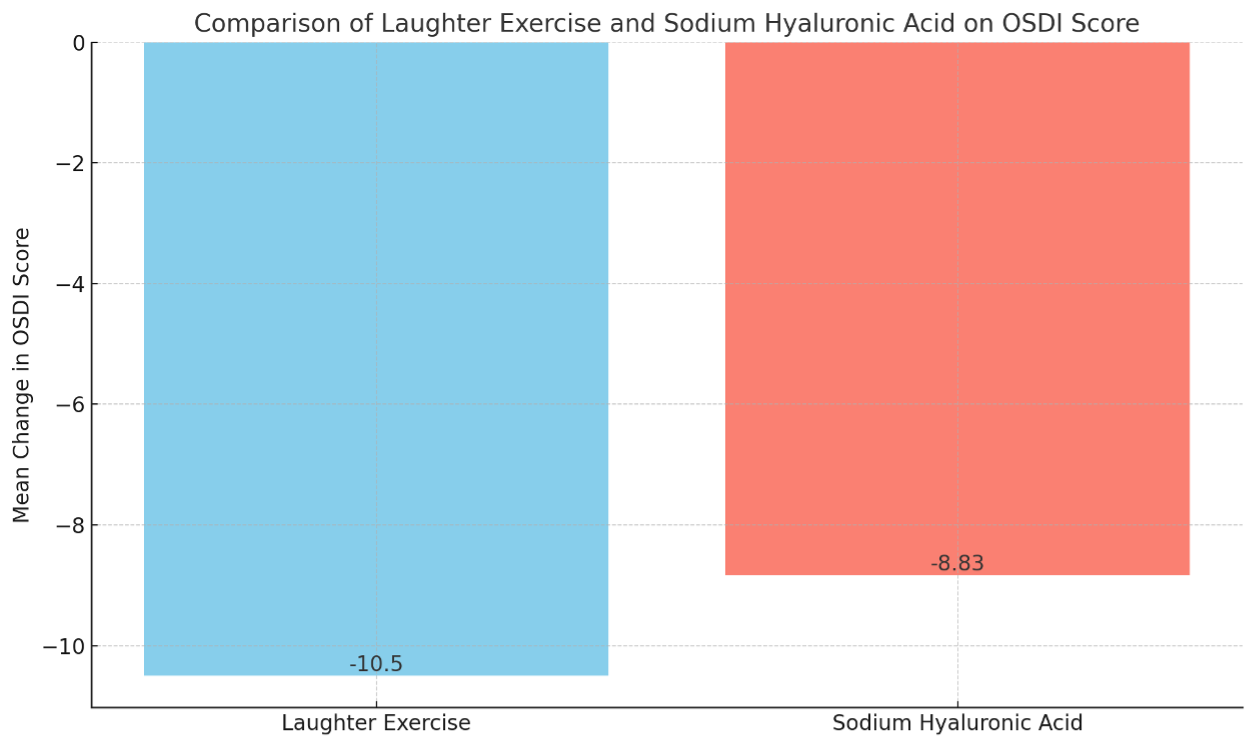
Introduction
Dry eye disease is a common and complex condition characterized by chronic eye discomfort, tear film instability, and visual disturbances, affecting approximately 360 million people worldwide. Contributing factors include aging, increased use of digital devices, and environmental pollutants. While artificial tears are the primary treatment, dry eye disease significantly impacts quality of life and imposes economic burdens, particularly on long-term users.
In a new study published in the British Medical Journal, researchers in China and the U.K. demonstrate that a simple laughter exercise performed four times a day can rival the effectiveness of artificial tears in alleviating the symptoms of dry eye disease.
Studies have shown a link between dry eye disease and mental health conditions such as depression and anxiety, with symptoms of dry eye being more strongly correlated with these mental health issues than clinical signs. Laughter Yoga, known for its benefits in reducing depression, anxiety, and stress, has been explored as a potential treatment for dry eye disease.
Faculties and Collaborating Institutions:
1. Zhongshan Ophthalmic Center, Sun Yat-sen University, Guangzhou, China.
2. Queen’s University Belfast, Belfast, UK.
3. Orbis International, New York, USA.
4. Xiamen Eye Center, Xiamen University, Fujian, China.
5. University of South China, Hengyang, Hunan, China.
When and Where:
Date: The study was conducted between June 18, 2020, and January 8, 2021.
Location: Zhongshan Ophthalmic Center, Sun Yat-sen University, Guangzhou, China.
Objective:
The primary goal was to assess whether laughter exercises could be as effective as 0.1% sodium hyaluronic acid (an artificial tear) in reducing symptoms of dry eye disease. Specifically, the study sought to establish whether laughter exercises could achieve similar or better results in improving eye discomfort, tear stability, and overall well-being compared to artificial tears.
Study Design (Protocol):
Participants: The trial involved 299 people aged 18-45, all diagnosed with symptomatic dry eye disease. To qualify, participants had to show symptoms like eye discomfort and reduced tear film stability (tear film breakup time ≤8 seconds). OSDI scores (a measure of ocular surface discomfort) ranged from 18 to 80.
Randomisation: Participants were randomly divided into two groups:
Laughter Exercise Group: 149 participants performed laughter exercises. This involved repeating phrases such as "Hee hee hee," "Hah hah hah," and "Cheese cheese cheese" for five minutes, four times a day. The participants were shown an instructional video to guide them through the process.
Control Group (Artificial Tears): 150 participants applied 0.1% sodium hyaluronic acid eye drops four times daily.
Duration: The intervention lasted for 8 weeks. Follow-ups were conducted at 2, 4, 6, 8, 10, and 12 weeks.
Tools for Compliance: Participants in both groups used a specially designed face recognition app ("laughing face") to track their adherence to the intervention. The app sent reminders to complete exercises or apply eye drops.
Outcome Measures:
Primary Outcome:
The main focus was on the change in OSDI scores from baseline to 8 weeks. Higher OSDI scores indicate worse discomfort. The non-inferiority margin was set at 6 points, meaning that if the difference between the two groups was within 6 points, the laughter exercise would be considered non-inferior to eye drops.
Secondary Outcomes:
Improvement in tear break-up time (a measure of tear film stability).
Proportion of participants who experienced a reduction in OSDI scores by at least 10 points.
Improvement in general health measures (mental health, anxiety, depression, happiness, and sleep quality).
Results:
Primary Outcome (OSDI Scores): After 8 weeks, both groups showed significant improvements in OSDI scores:
Laughter Exercise Group: A decrease of 10.5 points.
Control Group: A decrease of 8.83 points. The difference between the two groups was within the non-inferiority margin, meaning laughter exercises were as effective as the artificial tears.

Secondary Outcomes:
Tear Break-Up Time: The laughter exercise group saw a greater improvement in tear film stability, with an increase of 2.30 seconds, compared to 0.92 seconds in the control group.

Here is the bar chart comparing the effects of laughter exercises and sodium hyaluronic acid eye drops (0.1%) on tear break-up time. The mean change values are displayed at the top of each bar, along with the 95% confidence intervals. Laughter exercises showed a significantly greater improvement in tear break-up time compared to the eye drops.
Other Health Measures: Both groups showed improvements in mental health and anxiety, but no significant difference in happiness and sleep quality was observed between the groups.
No Adverse Effects: Neither group experienced any adverse side effects, confirming the safety of both interventions.
Conclusion:
The study concluded that laughter exercise is a safe, and low-cost alternative to 0.1% sodium hyaluronic acid for alleviating dry eye symptoms. In addition to improving tear stability, laughter exercises have the added benefits of improving mental health and promoting a more positive emotional state, making it a suitable home-based intervention for people with dry eye disease.
Please click on the link to get the original research article https://tinyurl.com/5c5be6dh
